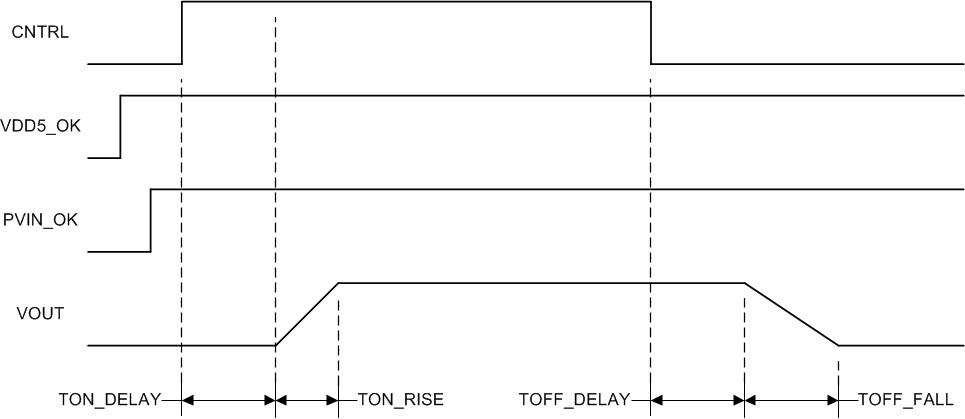SLUSEJ1A December 2021 – November 2023 TPSM8D6C24
PRODUCTION DATA
- 1
- 1 Features
- 2 Applications
- 3 Description
- 4 Pin Configuration and Functions
- 5 Specifications
-
6 Detailed Description
- 6.1 Overview
- 6.2 Functional Block Diagram
- 6.3
Feature Description
- 6.3.1 Average Current-Mode Control
- 6.3.2 Linear Regulators
- 6.3.3 AVIN and PVIN Pins
- 6.3.4 Input Undervoltage Lockout (UVLO)
- 6.3.5 Start-Up and Shutdown
- 6.3.6 Differential Sense Amplifier and Feedback Divider
- 6.3.7 Set Output Voltage and Adaptive Voltage Scaling (AVS)
- 6.3.8 Prebiased Output Start-Up
- 6.3.9 Soft Stop and (65h) TOFF_FALL Command
- 6.3.10 Power Good (PGOOD)
- 6.3.11 Set Switching Frequency
- 6.3.12 Frequency Synchronization
- 6.3.13 Loop Follower Detection
- 6.3.14 Current Sensing and Sharing
- 6.3.15 Telemetry
- 6.3.16 Overcurrent Protection
- 6.3.17 Overvoltage and Undervoltage Protection
- 6.3.18 Overtemperature Management
- 6.3.19 Fault Management
- 6.3.20 Back-Channel Communication
- 6.3.21 Switching Node (SW)
- 6.3.22 PMBus General Description
- 6.3.23 PMBus Address
- 6.3.24 PMBus Connections
- 6.4 Device Functional Modes
- 6.5 Programming
- 6.6
Register Maps
- 6.6.1 Conventions for Documenting Block Commands
- 6.6.2 (01h) OPERATION
- 6.6.3 (02h) ON_OFF_CONFIG
- 6.6.4 (03h) CLEAR_FAULTS
- 6.6.5 (04h) PHASE
- 6.6.6 (10h) WRITE_PROTECT
- 6.6.7 (15h) STORE_USER_ALL
- 6.6.8 (16h) RESTORE_USER_ALL
- 6.6.9 (19h) CAPABILITY
- 6.6.10 (1Bh) SMBALERT_MASK
- 6.6.11 (1Bh) SMBALERT_MASK_VOUT
- 6.6.12 (1Bh) SMBALERT_MASK_IOUT
- 6.6.13 (1Bh) SMBALERT_MASK_INPUT
- 6.6.14 (1Bh) SMBALERT_MASK_TEMPERATURE
- 6.6.15 (1Bh) SMBALERT_MASK_CML
- 6.6.16 (1Bh) SMBALERT_MASK_OTHER
- 6.6.17 (1Bh) SMBALERT_MASK_MFR
- 6.6.18 (20h) VOUT_MODE
- 6.6.19 (21h) VOUT_COMMAND
- 6.6.20 (22h) VOUT_TRIM
- 6.6.21 (24h) VOUT_MAX
- 6.6.22 (25h) VOUT_MARGIN_HIGH
- 6.6.23 (26h) VOUT_MARGIN_LOW
- 6.6.24 (27h) VOUT_TRANSITION_RATE
- 6.6.25 (29h) VOUT_SCALE_LOOP
- 6.6.26 (2Bh) VOUT_MIN
- 6.6.27 (33h) FREQUENCY_SWITCH
- 6.6.28 (35h) VIN_ON
- 6.6.29 (36h) VIN_OFF
- 6.6.30 (37h) INTERLEAVE
- 6.6.31 (38h) IOUT_CAL_GAIN
- 6.6.32 (39h) IOUT_CAL_OFFSET
- 6.6.33 (40h) VOUT_OV_FAULT_LIMIT
- 6.6.34 (41h) VOUT_OV_FAULT_RESPONSE
- 6.6.35 (42h) VOUT_OV_WARN_LIMIT
- 6.6.36 (43h) VOUT_UV_WARN_LIMIT
- 6.6.37 (44h) VOUT_UV_FAULT_LIMIT
- 6.6.38 (45h) VOUT_UV_FAULT_RESPONSE
- 6.6.39 (46h) IOUT_OC_FAULT_LIMIT
- 6.6.40 (47h) IOUT_OC_FAULT_RESPONSE
- 6.6.41 (4Ah) IOUT_OC_WARN_LIMIT
- 6.6.42 (4Fh) OT_FAULT_LIMIT
- 6.6.43 (50h) OT_FAULT_RESPONSE
- 6.6.44 (51h) OT_WARN_LIMIT
- 6.6.45 (55h) VIN_OV_FAULT_LIMIT
- 6.6.46 (56h) VIN_OV_FAULT_RESPONSE
- 6.6.47 (58h) VIN_UV_WARN_LIMIT
- 6.6.48 (60h) TON_DELAY
- 6.6.49 (61h) TON_RISE
- 6.6.50 (62h) TON_MAX_FAULT_LIMIT
- 6.6.51 (63h) TON_MAX_FAULT_RESPONSE
- 6.6.52 (64h) TOFF_DELAY
- 6.6.53 (65h) TOFF_FALL
- 6.6.54 (78h) STATUS_BYTE
- 6.6.55 (79h) STATUS_WORD
- 6.6.56 (7Ah) STATUS_VOUT
- 6.6.57 (7Bh) STATUS_IOUT
- 6.6.58 (7Ch) STATUS_INPUT
- 6.6.59 (7Dh) STATUS_TEMPERATURE
- 6.6.60 (7Eh) STATUS_CML
- 6.6.61 (7Fh) STATUS_OTHER
- 6.6.62 (80h) STATUS_MFR_SPECIFIC
- 6.6.63 (88h) READ_VIN
- 6.6.64 (8Bh) READ_VOUT
- 6.6.65 (8Ch) READ_IOUT
- 6.6.66 (8Dh) READ_TEMPERATURE_1
- 6.6.67 (98h) PMBUS_REVISION
- 6.6.68 (99h) MFR_ID
- 6.6.69 (9Ah) MFR_MODEL
- 6.6.70 (9Bh) MFR_REVISION
- 6.6.71 (9Eh) MFR_SERIAL
- 6.6.72 (ADh) IC_DEVICE_ID
- 6.6.73 (AEh) IC_DEVICE_REV
- 6.6.74 (B1h) USER_DATA_01 (COMPENSATION_CONFIG)
- 6.6.75 (B5h) USER_DATA_05 (POWER_STAGE_CONFIG)
- 6.6.76 (D0h) MFR_SPECIFIC_00 (TELEMETRY_CONFIG)
- 6.6.77 (DAh) MFR_SPECIFIC_10 (READ_ALL)
- 6.6.78 (DBh) MFR_SPECIFIC_11 (STATUS_ALL)
- 6.6.79 (DCh) MFR_SPECIFIC_12 (STATUS_PHASE)
- 6.6.80 (E4h) MFR_SPECIFIC_20 (SYNC_CONFIG)
- 6.6.81 (ECh) MFR_SPECIFIC_28 (STACK_CONFIG)
- 6.6.82 (EDh) MFR_SPECIFIC_29 (MISC_OPTIONS)
- 6.6.83 (EEh) MFR_SPECIFIC_30 (PIN_DETECT_OVERRIDE)
- 6.6.84 (EFh) MFR_SPECIFIC_31 (DEVICE_ADDRESS)
- 6.6.85 (F0h) MFR_SPECIFIC_32 (NVM_CHECKSUM)
- 6.6.86 (F1h) MFR_SPECIFIC_33 (SIMULATE_FAULT)
- 6.6.87 (FCh) MFR_SPECIFIC_44 (FUSION_ID0)
- 6.6.88 (FDh) MFR_SPECIFIC_45 (FUSION_ID1)
-
7 Application and Implementation
- 7.1 Application Information
- 7.2
Typical Application
- 7.2.1 Design Requirements
- 7.2.2
Detailed Design Procedure
- 7.2.2.1 Custom Design With WEBENCH® Tools
- 7.2.2.2 Switching Frequency
- 7.2.2.3 Output Voltage Setting (VSEL Pin)
- 7.2.2.4 Compensation Selection (MSEL1 Pin)
- 7.2.2.5 Output Capacitor Selection
- 7.2.2.6 Input Capacitor Selection
- 7.2.2.7 Soft Start, Overcurrent Protection, and Stacking Configuration (MSEL2 Pin)
- 7.2.2.8 Enable and UVLO
- 7.2.2.9 ADRSEL
- 7.2.2.10 BCX_CLK and BCX_DAT
- 7.2.3 Application Curves
- 7.3
Two-Phase Application
- 7.3.1 Design Requirements
- 7.3.2
Two-Phase Detailed Design Procedure
- 7.3.2.1 Switching Frequency
- 7.3.2.2 Output Voltage Setting (VSEL Pin)
- 7.3.2.3 Compensation Selection (MSEL1 Pin)
- 7.3.2.4 Output Capacitor Selection
- 7.3.2.5 Input Capacitor Selection
- 7.3.2.6 GOSNS/Loop Follower Pin of Loop Follower Devices
- 7.3.2.7 Soft Start, Overcurrent Protection, and Stacking Configuration (MSEL2 Pin)
- 7.3.2.8 Enable, UVLO
- 7.3.2.9 VSHARE Pin
- 7.3.2.10 SYNC Pin
- 7.3.2.11 VOSNS Pin of Loop Follower Devices
- 7.3.2.12 Unused Pins of Loop Follower Devices
- 7.3.3 Application Curves
- 7.4 Four-Phase Application
- 7.5 Power Supply Recommendations
- 7.6 Layout
- 8 Device and Documentation Support
- 9 Revision History
- 10Mechanical, Packaging, and Orderable Information
Package Options
Mechanical Data (Package|Pins)
- MOW|59
Thermal pad, mechanical data (Package|Pins)
Orderable Information
6.3.5 Start-Up and Shutdown
The start-up and shutdown of the device is controlled by several PMBus programmable values including:
- (01h) OPERATION(01h) OPERATION(01h) OPERATION(01h) OPERATION(01h) OPERATION(01h) OPERATION(01h) OPERATION(01h) OPERATION(01h) OPERATION
- (02h) ON_OFF_CONFIG(02h) ON_OFF_CONFIG(02h) ON_OFF_CONFIG(02h) ON_OFF_CONFIG(02h) ON_OFF_CONFIG(02h) ON_OFF_CONFIG(02h) ON_OFF_CONFIG(02h) ON_OFF_CONFIG(02h) ON_OFF_CONFIG(02h) ON_OFF_CONFIG
- (60h) TON_DELAY
- (61h) TON_RISE(61h) TON_RISE(61h) TON_RISE(61h) TON_RISE(61h) TON_RISE(61h) TON_RISE
- (64h) TOFF_DELAY(64h) TOFF_DELAY
- (65h) TOFF_FALL(65h) TOFF_FALL(65h) TOFF_FALL(65h) TOFF_FALL
With the default (02h) ON_OFF_CONFIG(02h) ON_OFF_CONFIG(02h) ON_OFF_CONFIG(02h) ON_OFF_CONFIG(02h) ON_OFF_CONFIG(02h) ON_OFF_CONFIG(02h) ON_OFF_CONFIG(02h) ON_OFF_CONFIG(02h) ON_OFF_CONFIG(02h) ON_OFF_CONFIG settings, the timing is as shown in Figure 6-6. See the Supported PMBus CommandsSupported PMBus Commands section for full details on the implementation.
 Figure 6-6 TPSM8D6C24 Start-Up and
Shutdown
Figure 6-6 TPSM8D6C24 Start-Up and
ShutdownThe TPSM8D6C24 requires time between the AVIN and VDD5 reaching their UVLO levels for pin-detection and PMBus communication and valid sensing of EN/UVLO and PVIN_OK. Once AVIN and VDD5 exceed their lower UVLO thresholds (2.9-V typical), the TPSM8D6C24 starts its power-on-reset, self-calibration, and pin-detection. This time delay, tdelay(uvlo_PMBus) (6-ms typical), must be complete before PVIN_OK or EN/UVLO sensing is enabled.
If VDD5PS_ON, PVIN_OK, and EN/UVLO are above their thresholds before the end of tdelay(uvlo_PMBus), (60h) TON_DELAY starts after tdelay(uvlo_PMBus) completes.
If VDD5PS_ON, PVIN_OK, or EN/UVLO are below their thresholds when tdelay(uvlo_PMBus) completes, (60h) TON_DELAY starts when VDD5_OK, PVIN_OK, and EN/UVLO are all above their thresholds.